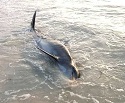 News that the morbillivirus outbreak area spread from Brevard County to the Keys this week is almost a worst-case scenario, scientists say. A necropsy performed on an Atlantic bottlenose dolphin that died on Nov. 7 after washing up sick on the Bahia Honda State Park beach earlier that day returned positive Tuesday for the deadly measles-like disease that is highly contagious among sea mammals.
News that the morbillivirus outbreak area spread from Brevard County to the Keys this week is almost a worst-case scenario, scientists say. A necropsy performed on an Atlantic bottlenose dolphin that died on Nov. 7 after washing up sick on the Bahia Honda State Park beach earlier that day returned positive Tuesday for the deadly measles-like disease that is highly contagious among sea mammals.
Until now, Keys’ bottlenose dolphins were considered a “naïve population,” meaning the endemic mammals had not been exposed to the virus. Not having morbillivirus here is a good thing, but it also means that Keys dolphins do not have the antibodies in their system to fight off the disease should they become exposed. This makes the population prone to a large die-off.
“Everyone was really hoping it wasn’t going to move south of Brevard County,” said Jill L. Richardson, a biologist with the University of Miami’s Rosenstiel School of Marine and Atmospheric Science. “Because this is a semi-naïve population, it’s pretty upsetting it has been identified in the Keys.”
Federal fisheries scientists declared this week that the outbreak area of the virus, which has killed 1,569 dolphins from New York to Central Florida since July 2013, now includes the Atlantic side of the Keys. And the entire Gulf of Mexico and Florida Bay side of Florida is now considered a “surveillance area” for the outbreak, said Laura Engleby, a biologist and chief of the National Oceanic and Atmospheric Administration’s southeast marine-mammal branch.
“It takes a little while to run the tests to confirm morbillivirus,” Engleby said in a phone interview Tuesday. “We suspected it was morbilli, but we wanted to wait to say it until we were absolutely 100 percent sure, and now we are.”
Until now, the farthest south a morbillivirus case associated with the current outbreak reached was in the Indian River Lagoon in Brevard County. The first confirmed case there was in October 2013. There have since been about 10 dolphins found in the area infected with morbillivirus.
Despite the concern over the Keys case, there is no elevation in the number of strandings associated with this outbreak. In fact, scientists have noticed a slowdown in strandings nationwide, especially from Georgia to New York. Northern Florida strandings are still considered elevated, however.
The Keys are home to several captive marine mammal facilities where dolphins are kept in enclosed lagoons supplied with seawater directly from the ocean.
Since morbillivirus is so contagious, NOAA has informed the U.S. Department of Agriculture, the federal agency with jurisdiction over marine mammal parks, that morbillivirus is now in the Keys.
The virus affects marine mammals’ lungs, neurological systems and immune systems. There has never been a case a human catching morbillivirus from a marine mammal, Engleby said.
But associated byproduct illnesses can be passed, and that is why scientists are warning people not to touch stranded mammals they might see on the beach. People should also not let their pets approach sick mammals.
The few dolphins and whales with morbillivirus that scientists find alive usually show signs of respiratory problems, brain damage and other illnesses that result from their weakened immune systems caused by the disease. They are usually in such bad shape that veterinarians euthanize the mammals even before tests are conducted.
“Mammals suspected of having morbillivirus are not candidates for rehabilitation,” Engleby said.
Keys captive mammal facilities say they are “on their toes” in the wake of the outbreak’s spread, but they add they have always been prepared to keep their dolphins safe from morbillivirus.
“Everyone should be aware, but they shouldn’t panic,” said Ted Turner, zoological director at Key Largo’s Island Dolphin Care. “The dolphins here have no direct contact with wild animals.”
Part of the precaution captive mammal facilities take, and have taken for years, is keeping people away from their animals who have been around sick dolphins and whales.
“Since the [outbreak] was first declared, we have screened visitors at the entrance, asking if they have been to a stranding center or come in contact with any stranded marine mammal,” said Mary Stella, of the Dolphin Research Center in Grassy Key. “We continue to ask this question of every guest.”
Turner is a member of the stranding network, meaning he is among those called to volunteer to respond to a seen of marine mammal strandings and beachings. But he will not be a part of the network as long as he works for Island Dolphin Care.
Continue reading this article at this LINK.…
—–
Join ODU Magazine on Facebook here at this LINK…..
Join ODU Magazine on our Twitter fishing site here at this LINK…..
Join ODU Magazine on our Twitter hunting site here at this LINK…..
.
